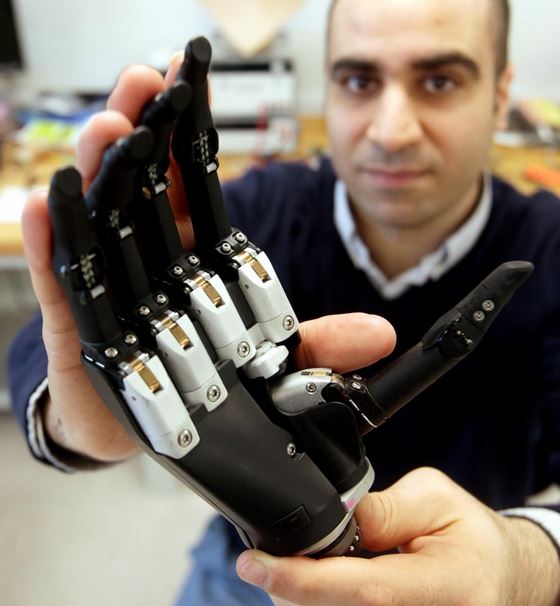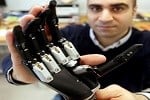An amazing bionic hand, reminiscent of Luke Skywalker’s prosthesis, can sense temperature and pressure and transmits the data back to the human brain, say researchers in a study led by Newcastle University, and including colleagues from the Universities of Southampton, Keele, Essex, Leeds, and Imperial College London.
The research, part of a new £1.4 million project funded by the Engineering and Physical Sciences Research Council (EPSRC), aims to develop new electronic prosthetic devices that connect to the forearm neural networks to allow 2-way communications with the brain.
The bionic limb’s electrodes will wrap around the nerve endings in the arm, making it possible for the hand to communicate directly to the brain, sending back real-time data about shear force, pressure and temperature.

Dr. Nazarpour showing the bionic hand that will connect directly with the brain. (Image: EPSRC)
Study leader, Dr Kianoush Nazarpour, a lecturer in Biomedical Engineering at Newcastle University, and colleagues hope to develop several enabling technologies to give amputees a real sense of feedback and create a limb that is virtually the same as the real thing.
Dr Nazarpour said:
“The UK leads the way in the design of prosthetic limbs but until now one of the limiting factors has been the technology to allow the hand to communicate with the brain.”
“If we can design a system that allows this two-way communication it would help people to naturally reach out and pick up a glass, for example, whilst maintaining eye contact in a conversation, or pick up an apple without bruising it.
“This will advance the field of prosthetics, provide enhanced function to prosthesis users, and also reduce the time involved to learn how to use the device because the movements will come naturally. The technology will also have applications for patients with neurological conditions where reduced sensation is a factor.”
Developing the bionic hand
Some of Britain’s leading experts in the field of rehabilitation research aim to build fingertip sensors that will give the prosthesis a realistic sense of touch, including shear, pressure and temperature.
A “virtual hand” will provide data on the sense of the hand’s proprioception – the ability to control the hand without having to look directly at it. Finally, the system will process the signals to a form the brain is able to understand so that it can stimulate the nervous system, thus helping the user control the hand.
With this level of feedback built into prosthetic devices, people who have lost their limbs will have far better levels of function compared with what is currently available.
Clinical advisor on the project, Dr. Rory O’Connor, Senior Lecturer in Rehabilitation Medicine at the University of Leeds, said:
“We are seeing many more active young people who are surviving severe injuries that result in them losing one or more limbs and requiring a prosthesis. The current designs are like a plug and socket. The socket fits over the end of the limb and picks up signals from the muscles.”
“The prosthesis fits onto this and by learning to flex certain muscles the patient can work the hand. The drawback is that for many patients – particularly survivors of trauma – the muscle ends are too damaged to be able to use the limb.”
“What patients tell us is they want something that is more intuitive and more closely replicates the natural movement and feel of a real hand and that is what we hope to achieve through this project.”
According to the EPSRC, There are 11.6 million disabled people in the UK. Almost 6.5 million British citizens have mobility impairments, 6.3 million have problems lifting or carrying, while 2.7 million have impaired coordination.
EPSRC’s £5.3 million award – Other projects
The EPSRC has awarded £5.3 to fund three projects:
1. The bionic hand.
2. A project to create a pair of smart trousers (US English: pants) to help disabled and elderly people walk.
3. A plan to make biosensors to monitor how rehabilitation patients use equipment or exercise.
Chief Executive of EPSRC, Philip Nelson, said:
“These research studies will improve patients’ lives, allow greater independence and benefit patients with a wide range of mobility and co-ordination difficulties. With the UK’s ageing population and a rise in disabilities EPSRC investment in healthcare research has a national impact.”

